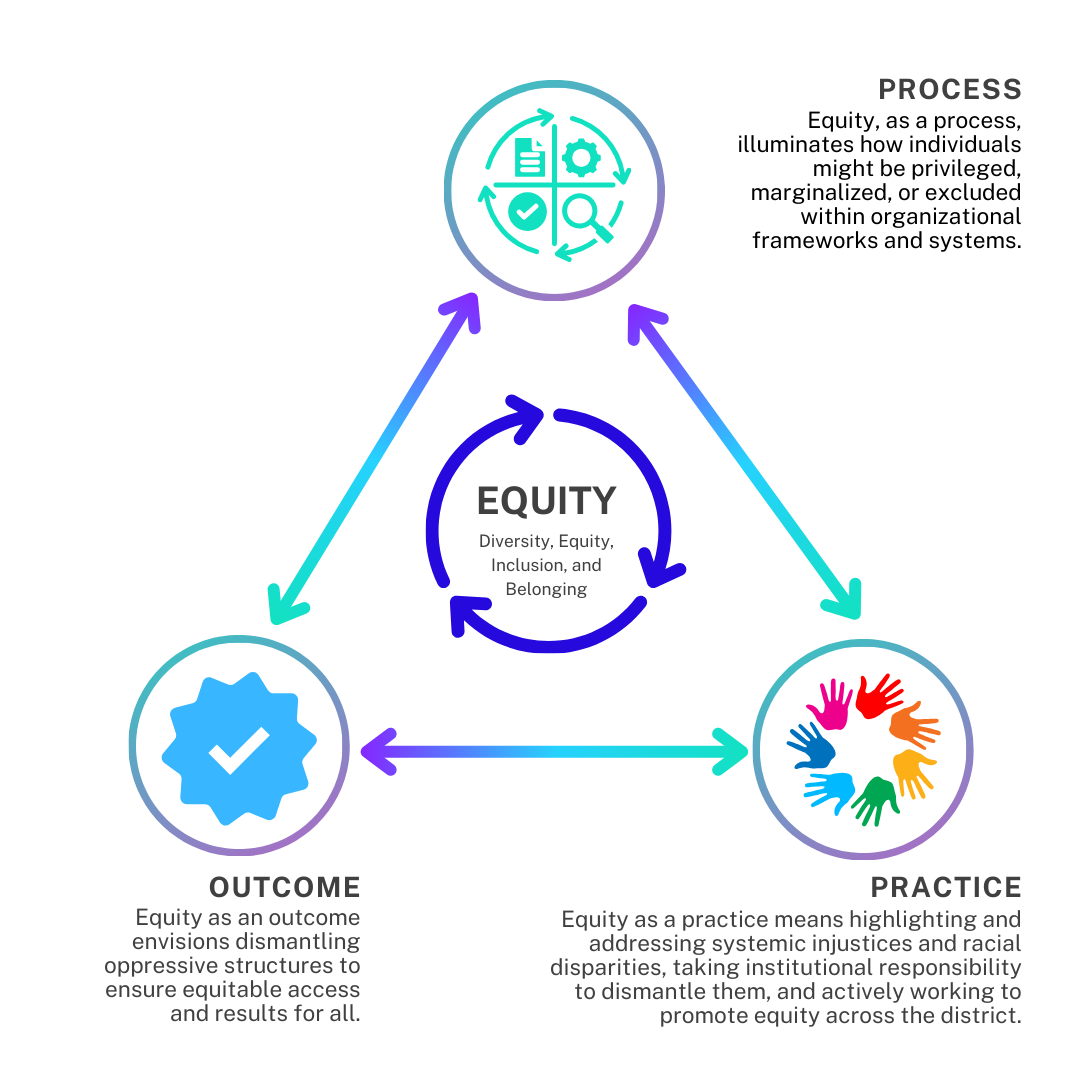Equity Framework
Through a series of collaborative meetings with members of the NOLA Public Schools District Leadership Team, we created the NOLA Public Schools Equity Framework – a comprehensive tool that will be used to support clear system-wide goals and objectives. While there continues to be a commitment to addressing all dimensions of equity, we know that a focus on race by all members of the NOLA Public Schools community will allow us to get to the deepest layers of the disparities we see in our system, allowing us to more appropriately direct resources and target areas of action for improvement.
NOLA Public Schools Equity Definition NOLA Public Schools defines equity as providing every student with the necessary resources, support, and opportunities to reach their full potential which involves ensuring fairness,
removing barriers, and
acknowledging individual differences for equal opportunities and student success in school.
Commitments
As we work toward actualizing this desired state, we will do so through the implementation of our EVOLVE Strategic Plan of Action that supports four core commitments. These commitments provide us with clear guidance and focus as we streamline our actions and align our beliefs.
Commitment 1 Being Clear, consistent, and transparent; and centering the voices of students, families, educators, and community stakeholders
Effective and Connected Communications
Commitment 2 High Quality Schools
Providing a quality school environment that prioritizes the needs of the whole child
Commitment 3 Student, Staff, and Community Well-being
Collaborating with diverse stakeholders to drive the best outcomes for students, staff, families, and community
Commitment 4 Operational Excellence
Driving the most healthy and sustainable conditions to ensure long-term viability
Defining Equity in Action
• Equity as a practice is when people and organizations consistently highlight and address systemic injustices and racial disparities, assume institutional responsibility for dismantling these disparities, and actively work towards promoting equity across organizational policies.
Advancing Equity How does the proposed policy, program, practice, decision, or action address or advance opportunities for equity across race and other identifiers, as defined by our SDP definition of equity?
Stakeholder Engagement Has your program office collected stakeholder input and feedback from members of the communities affected by this policy, program, practice, decision, or action? Consider race and other identifiers.
Funding and Resources What resources (i.e. funding, personnel, PD, etc.) would be necessary to successfully enact the current and/or recommended changes to this proposed policy, program, practice, decision, or action? Consider race and other identifiers.
Progress Monitoring and Evaluation How will you evaluate the progress of the proposed policy, program, practice, decision, or action to determine if it is achieving the desired results? Consider race and other identifiers.
Equity Lens Review Process
Advancing Equity How does the proposed policy, program, practice, decision, or action address or advance opportunities for equity across race and other identifiers, as defined by our SDP definition of equity?
Stakeholder Engagement Has your program office collected stakeholder input and feedback from members of the communities affected by this policy, program, practice, decision, or action? Consider race and other identifiers.
Funding and Resources What resources (i.e. funding, personnel, PD, etc.) would be necessary to successfully enact the current and/or recommended changes to this proposed policy, program, practice, decision, or action? Consider race and other identifiers.
Progress Monitoring and Evaluation How will you evaluate the progress of the proposed policy, program, practice, decision, or action to determine if it is achieving the desired results? Consider race and other identifiers.
To strengthen our individual and collective commitment to systemic change, we will utilize the following questions as we contemplate strategies and make decisions
Equity Beliefs
Our commitments and actions are rooted in the following beliefs
We believe all students achieve when our system works to ameliorate academic, social, and psychological barriers,and provides access to the resources that support academic learning and student led innovation
We believe the best kind of teaching cultivates a sense of belonging through well delivered culturally relevant instruction that is rigorous and embraces different ways of knowing and understanding
We believe it is our collective responsibility to build a learning environment that is supportive and inclusive of the most marginalized groups within the school community
We believe that engaging our parents, families, and communities in authentic interactions where their suggestions and concerns are seen and heard, is central to developing a framework of shared decision-making that amplifies their voices
We believe in being trusted stewards of public resources and the distribution of funding based on community need
NSBA Statement on Educational Equity: https://www.nsba.org/Advocacy/Equity Educational Equity. What Does It Mean? How Will We Know When We Reach It?: Whole Child Health: https://www.nsba4safeschools.org/css/topics/whole-child-health NSBA Center for Public Education Report - Educational Equity: What Does It Mean? How Do We Know When We Reach It? CPE Report: https://www.nsba.org/-/media/NSBA/File/cpe-educational-equity-research-briefjanuary-2016.pdf?la=en&hash=A0F139B97D13C589CE00F186E594BEF1C3396F93 NSBA Center for Public Education Brief - Educational Equity Research Brief: Resources to Support Challenging Conversations Courageous Conversations: https://courageousconversation.com/about/ Disagreement doesn’t have to be divisive: https://hbr.org/2020/11/disagreement-doesnt-have-to-be-divisive 3 stps to having difficult, but necessary conversations: https://ideas.ted.com/3-steps-to-having-difficult-butnecessary-conversations/ Additional Resources How much learning may be lost in the long run from COVID-19 and how can mitigation strategies help?: U.S. Population Projections: 2005-2050: https://www.pewresearch.org/hispanic/2008/02/11/us-populationprojections-2005-2050/19 The State of America’s Children, 2020: https://www.childrensdefense.org/wp-content/uploads/2020/02/TheState-Of-Americas-Children-2020.pdf Community Schools Playbook: https://communityschools.futureforlearning.org/ Leadership in Dual Language Education: https://www.cal.org/ndlf/pdfs/publications/NDLF-White-PaperOctober-2017.pdf Harming Our Common Future: America’s Segregated Schools 65 Years after Brown: https://www.civilrightsproject.ucla.edu/research/k-12-education/integration-and-diversity/harming-our-common-future-americas-segregatedschools-65-years-after-brown America Needs More Teachers of Color and a More Selective Teaching Profession: https://www.americanprogress.org/issues/education-k-2/reports/2017/09/14/437667/america-needs-teachers-color-selective-teachingprofession/ School Leadership: An untapped opportunity to draw young people of color into teaching: https://www.brookings.edu/blog/brown-center-chalkboard/2018/11/26/school-leadership-an-untapped-opportunity-to-draw-youngpeople-of-color-into-teaching/ Teachers, Schools, and Academic Achievement: https://econ.ucsb.edu/~jon/Econ230C/HanushekRivkin.pdf Erasing Inequities: https://www.ednc.org/wp-content/uploads/2019/08/EducationNC_Eraceing-Inequities.pdf Advanced Placement, International Baccalaureate, and Dual-Enrollment Courses: Availability, Participation, and Related Outcomes for 2009 Ninth-Graders: 2013: https://nces.ed.gov/pubs2019/2019430.pdf Understanding Culturally Responsive Teaching: Introducing the Culturally Responsive Curriculum Scorecard: A Tool to Evaluate Curriculum, 2019: National Institute of Mental Health Report on the Prevalence of Any Anxiety Disorder Among Adolescents: https://www.nimh.nih.gov/health/statistics/any-anxiety-disorder.shtml#part_155096 Mental Health, Substance Use, and Suicidal Ideation During the COVID-19 Pandemic — United States, June 24–30, 2020: https://www.cdc.gov/mmwr/volumes/69/wr/mm6932a1.htm?s_cid=mm6932a1_w Can Restorative Practices Improve School Climate and Curb Suspensions? https://www.rand.org/pubs/research_reports/RR2840.html Improving College and Career Readiness by Incorporating Social and Emotional Learning: https://ccrscenter.org/sites/default/files/Improving%20College%20and%20Career%20Readiness%20by%20Incorporating%20Social%20and%20Emotional%20Learning_0.pdf Creating Trauma Informed School Systems: https://www.nctsn.org/trauma-informed-care/trauma-informedsystems/schools/essential-elements The impact of enhancing students’ social and emotional learning: A meta-analysis of school-based universal interventions: Equity Toollkit




